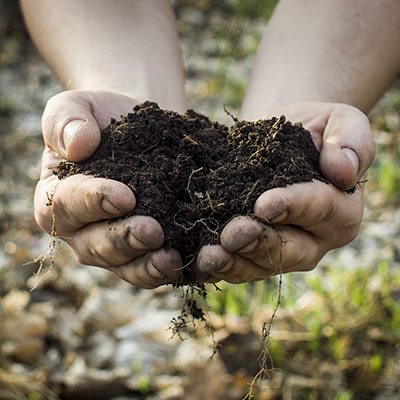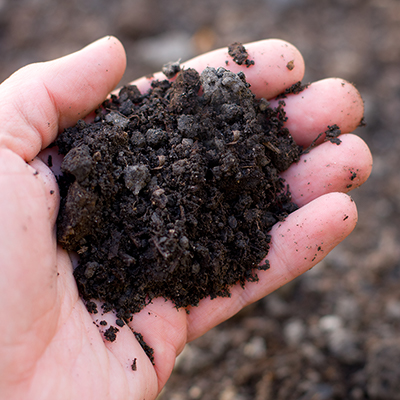How to Amend Problem Soils

Last updated July 18, 2025
It's a fact that expert gardeners know and newbie gardeners learn: successful flower and vegetable gardens begin with your soil. Problem soils can be rocky, sandy, saline, clay-like or compacted, making it hard for plants to grow. Use this guide to find tips for amending problem soil.
Keep in mind that poor soils don’t usually improve after just one addition of organic material. You’ll have better results when you add amendments on a regular basis. Testing your soil annually is a good way to monitor soil health that in turn keeps your plants growing strong.
Difficulty:
Beginner
Duration:
Under 2 hours
Table of Contents
How to Amend Rocky Soils
How to Amend Clay Soils
How to Amend Compacted Soils
How to Amend Sandy Soils
How to Amend Saline Soils
What is Soil pH and How Do I Amend It?
How to Amend Rocky Soils

Rocky soils often lack nutrients that plants need, and they’re not good at holding water. Additionally, rocky soils are hard to dig or till. Removing the rocks will make cultivating your garden easier and help plant roots penetrate the soil.
Once you’ve removed as many rocks as possible, use a shovel to break up the soil to a depth of about eight inches. Next, work in three to five inches of organic matter, such as compost or well-rotted manure.
Sometimes, rocks can be too small to extract from soil. If you have more rocks than you can remove, rake a layer of topsoil to your garden spot or plant your flowers or vegetables in raised beds filled with good quality organic planting soil.
How to Amend Clay Soils

While you can see rocks in your soil, it’s not as easy to know if it contains clay. Clay doesn’t let water drain readily, so pools of standing water are often signs of its presence. When clay soil dries out, it may crack along the surface.
To test for clay, use a garden trowel to dig up a small handful of subsoil (the layer of soil underneath the topsoil). Moisten the soil with water, shape it into a ball and drop the ball onto the ground. If it stays in a clump and doesn’t break apart, you have clay soil. Repeat this test with samples from different places in your garden, since you may not have clay everywhere.
You can improve clay soil, but don’t work it when it’s wet, and avoid walking on it so it doesn’t become compacted. When the soil is dry, add three to four inches of organic matter, such as compost, leaf mold or well-rotted manure (not peat moss), and work them into the soil about six inches deep. Mulch the soil with bark, wood chips or some other type of mulch that decomposes slowly. Over time, the sun and rain break down the mulch, which will also improve your soil.
Growing a cover crop from seed can also help. Try clover, winter rye or legumes to build up healthy soil. Sow the crop in the fall, after your garden is finished for the season. An added benefit of cover crops is that they help control erosion and keep weed seeds from sprouting. Cover crops can be turned under to add more organic matter to the soil when you plant again in spring.
How to Amend Compacted Soils

Heavy foot traffic can compact soil; so can driving over it. Once soil is compacted, water can’t easily penetrate. An aerator can help break up the soil if it isn’t severely compacted, so you can work in two or three inches of compost. Add pavers or stepping stones to help avoid further compacting the soil.
How to Amend Sandy Soils

Sandy soils aren’t good at holding water or nutrients, but they’re easy to identify. Sand feels gritty and won’t form a ball in your hand.
Fortunately, sandy soil is easy to dig, so work in two or three inches of peat moss or perlite to help it retain water. To add nutrients, work in compost, leaf mold, well-rotted manure or other organic matter. When you fertilize, choose a slow-release product. Liquid fertilizers can move through sandy soil too fast to benefit plants.
How to Amend Saline Soils

Plants can fail to thrive or die in soils with too much salt content. Saline soil can be present in arid regions, in areas with shallow water tables, near oceans or where minerals have weathered and broken down. Road salts can also accumulate in soil.
Improving saline soil is a challenge, so ask your County Extension Service agent for advice if this is a problem in your garden. Extension agents can also help you find salt-tolerant plants and suggest organic materials, if any, that may help improve your soil.
Tip: Raised garden beds and planters let you build quality soil for healthy plants. They're a good solution in areas with saline soil.
What is Soil pH and How Do I Amend It?

Soil pH refers to the acidity or alkalinity of soil. It’s measured from zero to 14. Acidic soils have a pH below 7.0, while alkaline soils measure over 7.0. Seven is neutral.
Soil pH is important because it affects the ability of plants to use nutrients. Most plants will do fine when the soil pH is between 6.0 (slightly acidic) to 7.5 (slightly alkaline). However, some plants, such as blueberries and azaleas, need slightly more acidic soil, and some trees, shrubs and perennials do better in alkaline soil.
A pH meter or test kit lets you measure your soil’s acidity or alkalinity so you can amend it, if indicated. It’s a good idea to take soil samples from various places in your garden and combine the measurements to get your average soil pH. Follow instructions in the soil test kit you purchased or you can use a soil test kit from your local County Extension agent.
If your soil is acidic, use ground limestone (lime) to raise the pH. If possible, apply it two or three months before planting, so it has time to work. Wood ashes from untreated wood will also raise pH. Spread ashes over the soil in the winter and work them in the next spring.
If your soil is alkaline, aluminum sulfate or sulfur will lower its pH. Aluminum sulfate changes the pH right away. Sulfur works more slowly. Changing your soil’s pH usually requires several treatments, so retest until you reach the pH you need. Also, retest when you plant a new garden.
Top-Dress Your Garden

Experts recommend that you regularly amend your soil with organic matter. Amend your pH as the soil pH testing indicates.
Vegetable gardens benefit from a top dressing of organic compost in spring and fall or in mid-season. Simply pull away any mulch and spread two to three inches of compost or well-rotted manure over the soil. Then replace the mulch. You don’t need to work the compost into the soil; it will break down naturally and release nutrients. As a bonus, top dressing can help discourage weeds from growing and help the soil retain moisture.
Looking for the right soil amendments and the tools for application? Search by voice or image and let The Home Depot Mobile App find it for you.


























